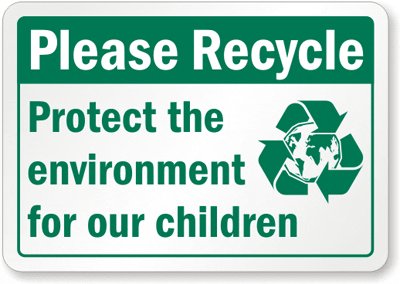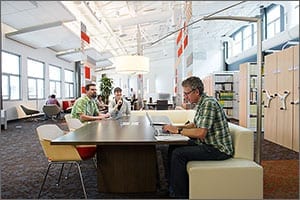
The idea struck me during a meeting.
While thoughts of waste don’t routinely course through my brain, trash was the subject matter at a meeting of Duke’s Campus Sustainability Committee whose broad focus is to maximize the sustainability of all Duke’s operations. The discussion in this particular meeting centered on how to reduce and eventually eradicate our waste stream.
The thing that really caught my attention was a report on the results of a series of student dumpster dives around campus. After collecting and sorting all the garbage, they found that about three-quarters of Duke‘s so-called non-recyclable trash destined for area landfills was compostable — things like food scraps, napkins, paper towels, etc. Based on calculations from government data [pdf], the national average is closer to 50 percent, but that’s still a lot of compost mostly headed for a landfill.
Trash Talking
You may call it trash or garbage, but the Environmental Protection Agency’s technical term for the stuff we toss into garbage cans and dumpsters is municipal solid waste: “everyday items we use and then throw away, such as product packaging, grass clippings, furniture, clothing, bottles, food scraps, newspapers, appliances, paint and batteries.”
The United States throws away some 250 million tons worth of this stuff a year — a hefty MSW number that places us solidly in the No. 1 spot for trash production.
On the bright side, not all the trash we Americans produce [pdf] ends up in landfills. Individually we recycle or compost about 1.5 pounds of the 4.5 pounds the average American produces every day. Nationally, approximately 26 percent of our waste stream is recycled, 12 percent is burned to produce energy and 8 percent is composted. Still, that leaves about 136 million tons piling up in landfills every year.
What to do?
One shining example of waste trimming is San Francisco, who reportedly “diverts 77% of its waste from landfills” and has its sights set on “zero waste” by 2020. Seattle and Los Angeles have also made great strides in shrinking their garbage footprint. Such initiatives (see also here and here) are certainly a move in the right direction.
But what about an approach that goes even further? One that does away with having to sort trash into the recycling box, the compost heap and the trash bin? One that doubles down on composting by moving up the value chain to create a “composting consumer economy.”
Moving Past Post-Consumer Recyclables to Post-Consumer Compost
Right now we send a lot of compostable materials to landfills. If you’ll pardon the pun, that’s a waste. Instead of being treated like trash, compostable items can be converted into organic-rich soil for growing crops.
And that could even help slow climate change. The anaerobic decay that occurs in landfills produces methane, a greenhouse gas that can escape into the atmosphere if a gas-capturing system is not installed. Composting, which is primarily an aerobic process, generates very little methane.
The Latest Bing News on:
Composting
- Want a 'no or low mow' lawn in Wilmington? Try composting.on May 10, 2024 at 2:05 am
Essentially, adding a healthy layer of compost will not only feed your plants but improve the character of your soil in terms of drainage, moisture retention, (disease-resistant) microbes, and more; ...
- Stronger regulations coming to tackle Ipswich composting facilitieson May 9, 2024 at 10:09 am
Don't miss out on the headlines from Ipswich. Followed categories will be added to My News. The proposed changes would force composting facilities near housing estates to use “in-vessel’’, or enclosed ...
- Cedar Rapids' composting: Slowing landfill fill-up, preventing gas harm, greening futureon May 8, 2024 at 3:24 pm
Around the world, over a billion tons of food is wasted each year.This week is International Compost Awareness Week and there are other things you can do with y ...
- Reading Terminal Market saves 30 tons of scraps in a month for composting piloton May 7, 2024 at 5:00 pm
In the month since Philadelphia's century-old public market began saving some of its food scraps, it's already returned 30 tons of fruit peels, eggshells and coffee grounds to the dirt. Reading ...
- Composting for a Better World!on May 6, 2024 at 8:04 pm
International Compost Awareness Week is here, and we asked our local organic champions Santos Organics whether there was any point in composting our organics and using compost to create a healthier ...
- Foodbank of Santa Barbara County prepares for new composting machineon May 6, 2024 at 11:18 am
The Foodbank of Santa Barbara County announced that it has been awarded a big boost in its mission to reduce greenhouse emissions and minimize environmental impact.
- Longmont promotes International Compost Awareness Week amid calls for more local composting optionson May 6, 2024 at 9:52 am
It comes at a time when Longmont and Boulder County residents are asking for additional local composting options and the ability to compost more items. The Longmont City Council unanimously approved a ...
- The key to good soil is compostingon May 6, 2024 at 2:29 am
A good soil foundation will produce healthy root systems which means healthy plants. The best way to build good soil is to add compost. International Compost Awareness Week (ICAW) is May 5-11. The ...
- YIMBY: Community composting for connection and climate actionon May 5, 2024 at 5:53 pm
YIMBY is short for ‘yes in my backyard’. It’s a community-run, backyard composting scheme that was founded in 2020 in Castlemaine, Victoria. To organisers' knowledge, there’s no other program like it ...
- Human composting and timber marketplaces: talking “industrial” VC with investor Dayna Graysonon May 4, 2024 at 1:29 pm
While the venture world is abuzz over generative AI, Dayna Grayson, a longtime venture capitalist who five years ago co-founded her own firm, Construct Capital, has been focused on comparatively ...
The Latest Google Headlines on:
Composting
[google_news title=”” keyword=”composting” num_posts=”10″ blurb_length=”0″ show_thumb=”left”] [/vc_column_text]The Latest Bing News on:
Non-recyclable trash
- Green Land Recycling Solutions: Pioneering the way to a greener tomorrowon May 10, 2024 at 4:11 am
Green Land Recycling Solutions is at the forefront of revolutionising ... including filling pillows, mattresses, insulation, or non-visible sections of bags, toys, and backpacks, replacing ...
- Mixed reactions to Defra’s Simpler Recycling announcementon May 10, 2024 at 2:37 am
There has been mixed reactions to Defra's announcement that councils should provide at least a fortnightly collection for residual waste.
- Simplified Environmental Solutions (SES) Expands Zero Waste to Landfill Operations to New Locations in Salt Lake City, Utah and Kansas City, Missourion May 10, 2024 at 12:37 am
Simplified Environmental Solutions (SES), an innovator in true zero waste to landfill material processing and management, has announced the opening of two ...
- San Jose enlisting the help of its residents to improve recycling rateson May 9, 2024 at 7:03 pm
Most recyclables are ending up in landfills but one Bay Area city is hoping to remedy that situation with the help of its community.
- Call2Recycle and Ascend Elements in recycling agreementon May 9, 2024 at 1:39 pm
A new recycling agreement between Ascend Elements, a Massachusetts-based provider of sustainable, closed-loop battery material solutions, and Call2Recycle, a ...
- How Politics And Litigation Impede Innovation In Plastics Recyclingon May 9, 2024 at 5:21 am
Plastics recycling has long been one of society's most intractable problems. A planned new set of court actions seems set to only delay real solutions.
- Recyclables to go in one bin under simpler collection rules, Government sayson May 8, 2024 at 4:01 pm
Recyclables to go in one bin under simpler collection rules, Government says - Under the new rules, people will be able to put plastic, metal, glass, paper and card in one bin.
- Healthcare Plastics Recycling Council: Case Study: Recycling Pilot for Non-Hazardous Medical Plastic Wasteon May 8, 2024 at 8:42 am
NORTHAMPTON, MA / ACCESSWIRE / May 8, 2024 / The medical plastic waste recycling pilot brought together B. Braun Medical Inc. (a medical device manufacturer of smart-infusion therapy and related produ ...
- Case Study: Recycling Pilot for Non-Hazardous Medical Plastic Wasteon May 8, 2024 at 8:15 am
NORTHAMPTON, MA / ACCESSWIRE / May 8, 2024 / The medical plastic waste recycling pilot brought together B. Braun Medical Inc. (a medical device manufacturer of smart-infusion therapy and related ...
- Are You Recycling Your Plastics the Right Way? What You Need to Knowon May 6, 2024 at 1:30 pm
R ecycling your plastics is a great way to help the environment, but you can't simply toss any water bottle or cellophane wrapper into the recycling bin -- some plastics are better off in the trash.
The Latest Google Headlines on:
Non-recyclable trash
[google_news title=”” keyword=”non-recyclable trash” num_posts=”10″ blurb_length=”0″ show_thumb=”left”]











